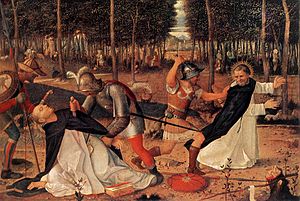User:Habasha/Aleramia: Difference between revisions
Jump to navigation
Jump to search
m (→Military) |
(Replaced content with "{{Infobox military conflict |conflict = Altipianese Crusade |image = File:SaintPeterTheMartyr'sAssasination detail.jpg |caption = 16th century rendering of the #Backgrou...") Tag: Replaced |
||
| (2 intermediate revisions by the same user not shown) | |||
| Line 1: | Line 1: | ||
{{Infobox | {{Infobox military conflict | ||
| | |conflict = Altipianese Crusade | ||
| | |image = File:SaintPeterTheMartyr'sAssasination detail.jpg | ||
|caption = 16th century rendering of the [[#Background|Massacre of the Redemptionists]] | |||
|partof = | |||
|date = March 997 – June 1011 | |||
|place = [[Aleramia#History|Duchy of the Altipian]], [[Aleramia]] | |||
|result = Crusader Victory | |||
|territory = | |||
|combatant1 = [[Alydiansism|Crusade]] | |||
| | *[[Cjargna|Bishopric of Cjargna]] | ||
*[[Umlena|County of Umlena]] | |||
*[[Aleram, Count of Altipian|Aleramic forces]] | |||
*[[Alydianism|Pontifical forces]] | |||
**[[Alydianism|Knights of Saint Eudocia]] | |||
**[[Alydianism|Order of Saint Agatha]] | |||
|combatant2 = [[Rohidianism|Rohidians]] | |||
*[[?]] | |||
*[[Altipian|Duchy of the Altipian]] | |||
*[[Vvarden]] (?) | |||
*[[Tigullio#History|Tigullian Republic]] | |||
|commander1 = [[Aleram, Count of Altipian|Aleram I]] <br> [[]] | |||
| | |commander2 = [[?]] {{KIA}}<br>[[?]] {{KIA}} | ||
| | |casualties1 = | ||
|casualties2 = Estimated between 100,000 and 350,000 | |||
| | |}} The '''Altipianese Crusade''' or the '''xx''' (997-1011, {{wpl|Gallo-Italic languages|Oronese:}} ''Cru'') was a 13-year military campaign waged by the [[?]] | ||
| | |||
| | |||
| | |||
| | |||
[[ | |||
[[ | |||
[[ | |||
{{ | |||
The | |||
Latest revision as of 21:16, 31 August 2019
| Altipianese Crusade | |||||||
|---|---|---|---|---|---|---|---|
 16th century rendering of the Massacre of the Redemptionists | |||||||
| |||||||
| Belligerents | |||||||
| Commanders and leaders | |||||||
|
Aleram I [[]] |
? † ? † | ||||||
| Casualties and losses | |||||||
| Estimated between 100,000 and 350,000 | |||||||
The Altipianese Crusade or the xx (997-1011, Oronese: Cru) was a 13-year military campaign waged by the ?